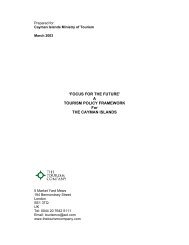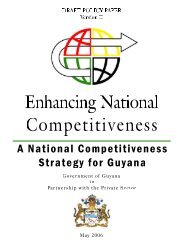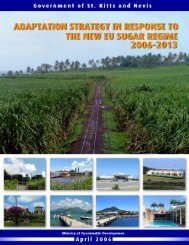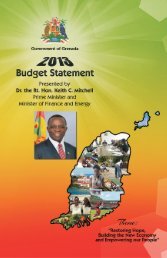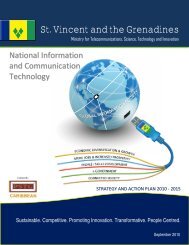Business Removing
Doing Business in 2005 -- Removing Obstacles to Growth
Doing Business in 2005 -- Removing Obstacles to Growth
- No tags were found...
You also want an ePaper? Increase the reach of your titles
YUMPU automatically turns print PDFs into web optimized ePapers that Google loves.
GETTING CREDIT 47<br />
losing possession. 15 And then the restrictions come. Specific<br />
descriptions of assets and debt preclude debtors<br />
from using changing pools of assets and future assets as<br />
collateral, preventing inventory and receivables financing.<br />
Some countries have tried to correct the problem. In<br />
1997 Panama introduced a floating charge over an entire<br />
business. But only for assets located outside the country.<br />
Paraguay allows borrowers to pledge inventory. But only<br />
if it consists of mining or industrial products. And each<br />
item must be listed individually. Angola, Egypt, Morocco<br />
and Vietnam permit nonpossessory pledges. But only to<br />
licensed banks.<br />
Such solutions always fall short. Potential borrowers<br />
with the wrong collateral miss out on loans. The answer<br />
is to create a universal security instrument, covering all<br />
assets and all debt, and letting all debtors and all creditors<br />
benefit.<br />
Establish registries for all collateral<br />
Collateral registries work best when they are unified by<br />
region and cover all types of assets. Even rich countries<br />
need reform. Austria, Germany and Switzerland have no<br />
collateral registries. 16 France operates local registries. And<br />
there are separate registries for pledges over shares, bank<br />
accounts, receivables and equipment. Separate registration<br />
with tax authorities is also required. Another 32 countries<br />
require multiple registration, including Cameroon,<br />
Colombia, Ecuador, Japan and Morocco. In Syria charges<br />
over movable property are possible only where there is a<br />
pre-existing registry—namely vehicles, vessels and intellectual<br />
property. Turkey has a similar system. The solution:<br />
create universal charges and a unified registry of movable<br />
property charges indexed by the name of the debtor.<br />
Indonesia established a registry in 2001. And Spain<br />
unified its registries in 1998. But Eastern European<br />
countries have led the way in establishing unified registries<br />
of charges over movable collateral. Bulgaria, Hungary,<br />
Romania and Moldova all successfully introduced<br />
such registries recently. Bosnia and Herzegovina is about<br />
to launch its unified registry. Since it was established in<br />
1998 the Macedonian registry has been used by banks as<br />
a standard part of lending. The most effective registries<br />
permit a simple administrative filing of a notice of the<br />
charge—and do not stall the registration process with<br />
legal review or authentication.<br />
The Romanian registry permits notice filing and is<br />
online, allowing creditors to check for existing liens instantly.<br />
Another 23 countries make the registry accessible<br />
electronically. Those that do often have significantly faster<br />
registration and more credit, controlling for other factors.<br />
Permit out of court collateral enforcement<br />
In 2000 Spain introduced out of court enforcement<br />
through notarial execution, allowing debtors and creditors<br />
to agree on enforcement methods. Time to enforce<br />
was cut from more than 1 year to 3 months. The gains<br />
from reforms in Slovakia were even larger. It took 560<br />
days to enforce a mortgage through the old system. Now<br />
it is possible to enforce in 45 days (figure 6.6).<br />
Ten years ago it was almost impossible to enforce<br />
collateral in India. The process could easily take 25 years.<br />
In 1998 the government established Debt Recovery Tribunals,<br />
with expedited enforcement proceedings. Expected<br />
time to enforce was cut to around 10 years. More<br />
reforms were introduced in May 2004. State-owned<br />
banks, which account for 90% of lending, were permitted<br />
to enforce out of court. On default the bank must<br />
notify the debtor. After a 60 day grace period the bank<br />
can seize the assets directly and sell by public auction.<br />
Introducing the reform was difficult—it had to survive a<br />
Supreme Court challenge. But the new procedure is widely<br />
used. Creditors can expect to enforce within 9 months.<br />
Designing out of court enforcement that doesn’t<br />
collapse at the first objection of the debtor cuts enforcement<br />
time by three-quarters on average. The less<br />
courts are involved, the shorter the time, and the more<br />
willing creditors are to lend. The point of collateral<br />
agreements is to avoid a regular trial. And if the case goes<br />
to court, efficiency can be improved by introducing<br />
summary proceedings—as in Estonia—without judicial<br />
analysis of the cause of the dispute, and with limitations<br />
on debtor’s ability to appeal.<br />
FIGURE 6.6<br />
Reform works—Slovakia before and after<br />
Days to enforce a mortgage<br />
Source: Doing <strong>Business</strong> database.<br />
Time reduced<br />
from 560 days to 45<br />
2003<br />
Procedures reduced from 14 to 6<br />
2004<br />
Number of procedures



